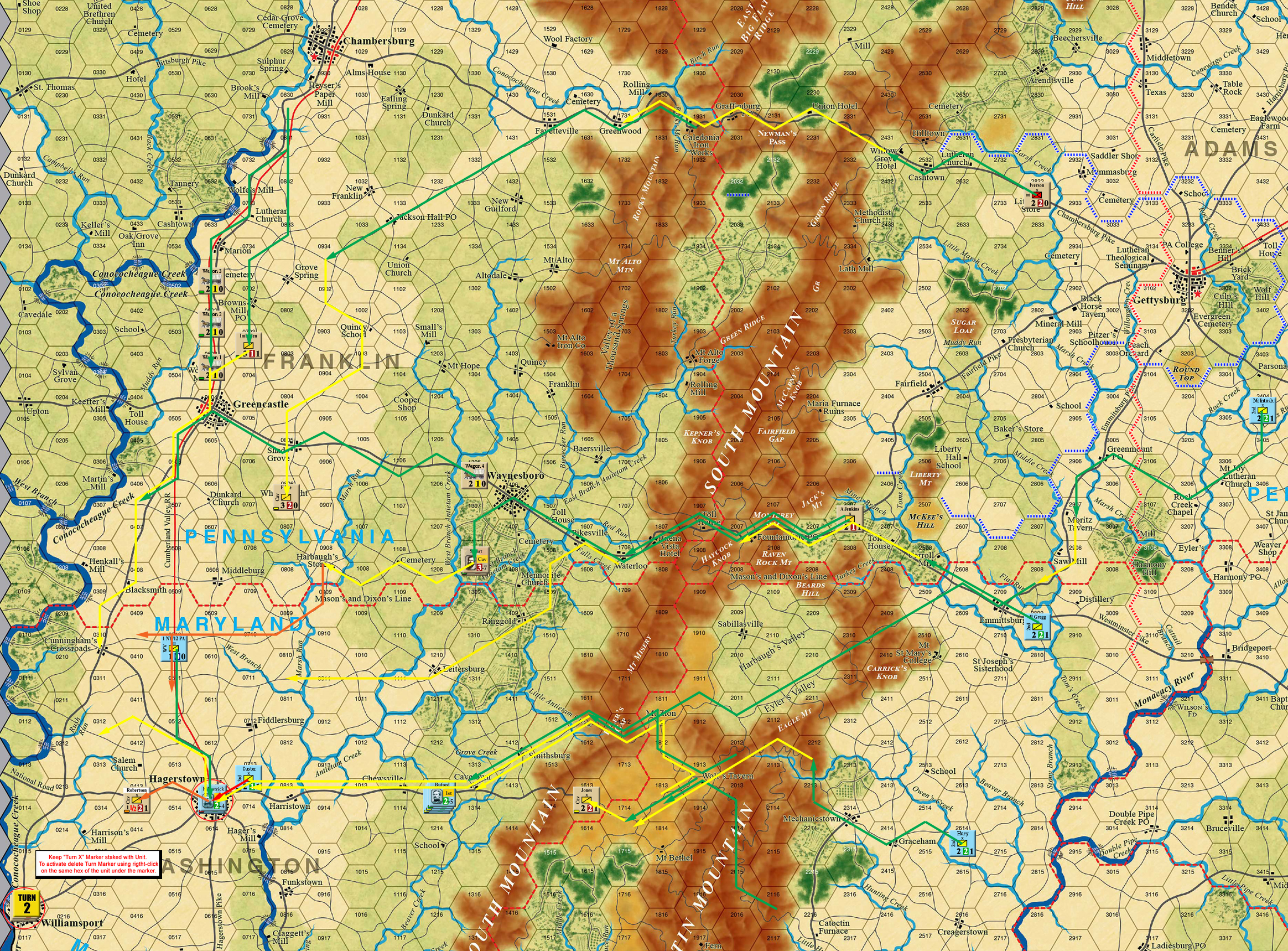The Wagoneer’s Flight
Mark and I returned to GCACW a bit ago, and after casting around a bit ended up with this unusual scenario from Roads to Gettysburg. It is July 4, 1863, and the Army of North Virginia is headed back to cross the Potomac, going south. The scenario concentrates on the effort to get the supplies away, while the main armies do their thing… outside of the scenario.
There’s some complex restrictions on who can go where (presumably because that’s where the main armies are). Thankfully, the Vassal module has nice a nice way of marking it all out; I don’t think I’d want to play this one FtF because of that, though once away from the start lines, it’s not a big problem, and the unit density is low enough.
I had the Confederates, who have several cavalry brigades scattered around, one exhausted infantry brigade (Iverson’s), and four wagon trains which need to get to Williamsport in three days. They can move with cavalry, and move about the same speed, but drop a movement point as soon as they go off-road, and are extra slow through woods or each other.
The Union goes first, and has most of the 1st-3rd Cavalry Divisions, plus a couple of independent regiments. East-west travel is restricted by South Mountain, Mt Alto, and other ridgeline spurs, with two main roads: The Chambersburg Pike over Newman’s Pass directly east of Gettysburg, with three of the wagons lined up on it (and Union access is largely cut off from it by the scenario rules), and the Westminster Pike over Monterey Gap somewhat further south. Both of our initial moves went towards securing this road. I got there first, and Buford went further south, exploring trails over Catoctin Mountain
I had some very good movement rolls, including a 12 for the second activation of the main set of wagons, which let them get past Chambersburg and on the Harrisburg Pike to Williamsport without straining. That said, the 1st NY/12th PA was able to get onto the pike ahead of them. Wagon 4, on the Fairfield Pike towards Monterey Gap, also did well, passing through Waynesboro at the end of its second move. As the turn wound down, Merritt had a shot at a prepared attack at Chambliss, who was guarding the paths south of the Westminster Pike, and Chambliss’ unit scattered under the pressure of a cavalry retreat.
The next day saw Kilpatrick and Buford work their way around Jones’ blocking force through Eyler’s Gap, and then Kilpatrick forced Robertson out of Hagerstown (worth 5 VP) with an assault (Custer failed to participate, and Richmond went to 4 fatigue on a Fa), disorganizing the unit, and interrupting a hoped-for recovery from exhaustion.

The rest of the day was partly Mark failing to bring in some of the more widely dispersed units (they had some very poor movement rolls), and maneuvering for position between the wagon trains and Hagerstown.
The first action of July 6 was Fitz Lee pushing the 1st NY/12th PA back towards Williamsport, but not actually clearing the road (I had fairly good odds, but rolled poorly) while hitting fatigue 4. The wagons moved up as far as they could, and Imboden came up to clear the road thanks to the Union squadrons being disorganized after their retreat. Kilpatrick started moving towards Williamsport, and I got the wagons there, sending Imboden to block the main road.
Maneuvering continued, with Buford coming up and Confederate units establishing a screen around Williamsport. McIntosh and Huey surrounded Jones, who retreated down South Mountain (losing 1 manpower) after partially blocking the pass for a day. Richmond forced Imboden back into Williamsport, Gamble pushed Fitz Lee back, and Jenkins retreated in the face of being flanked by the Federals. Custer lost part of his unit failing to shift Robertson. All this ended with the Confederates hemmed into a small pocket around Williamsport, but intact, with the wagons safe.
Afterword
The overall manpower losses were equal, so the only VPs were from the capture of Hagerstown, giving me a substantial victory. I got lucky. We both had some really good and some really bad movement rolls, but my wagons got average to way above average rolls on the first day, letting them cover a lot of ground undisturbed. Slow, or even average, wagons would be a very different start.
We both contemplated switching sides and going again, but I decided against it because our backlog is so huge. But its a very interesting scenario. Since most everything is cavalry, the action ranges over a fairly large area for three days. I also think it could be an usually good scenario for double-blind play. There’s more ways through then there are units to cover them all, so guessing what routes the enemy is using would be very important and make for an extra tense game.

Discussion ¬